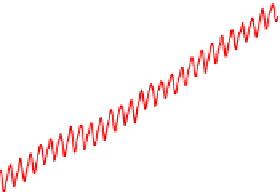Biomedical Engineering Reference
In-Depth Information
400
350
300
1960
1970
1980
1990
2000
2010
Year
FIGURE 15.9
Mole fraction of CO
2
in atmosphere from 1958 to 2011. Data from Mauna Loa Carbon Dioxide
Record.
sources may not be directly correlated to the atmospheric CO
2
level increase as depicted
by
Eqn (15.7)
. The growth rate of biomass may be dependent on the biomass density and
utilization of biomass also plays a role in the atmospheric CO
2
change.
The net effect of sending CO
2
into the atmosphere has been recognized by humanity. As
shown in
Fig. 15.9
, atmospheric CO
2
increases monotonously with time. It affects the very
living environment, which brings a constantly and monotonously changing earth. Net
emission of CO
2
into atmosphere (
Fig. 15.9
) is the cause of atmospheric CO
2
increase.
Changing does not automatically mean bad, but monotonous change is definitely not
sustainable. Soils and waters on earth can absorb/adsorb some of the CO
2
, relieving
some load in the atmosphere. Carbon sequestration through compressing CO
2
and
sending it “deep” under the earth where the fossils come from could be a temporal option.
However, these are still not sustainable processes. Rising level of carbonate in water or soil
does not bring any positive benefits that we can perceive. It is not difficult to imagine that
compressed CO
2
storing underneath earth is not a permanent solution. These are also
dead ends to CO
2
.Asdemonstratedin
Figs 15.8 and 15.9
, there is no sustainable state
(or steady constant CO
2
level in the atmosphere) in sight if the fossil energy consumption
continued.
If we have a long enough time scale, sustainability prevails eventually as matter and
energy are conserved. Everything is recyclable/renewable. However, there is an acceptable
time scale for the continuity in the existence of humanity and this time scale is not long
enough for fossils to be renewable. Therefore, it is imperative to find alternatives to fossil
sources since the time scale for fossils to recycle or naturally replenish is, at best, on the order
of 280 million years, as shown in
Table 15.4
. Fossils are replenished when a carbonaceous age






































Search WWH ::

Custom Search